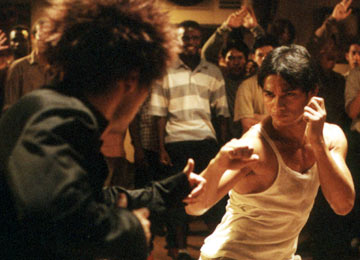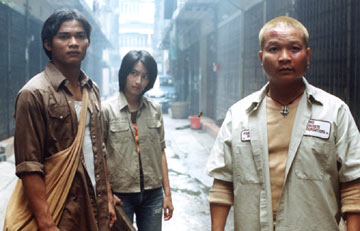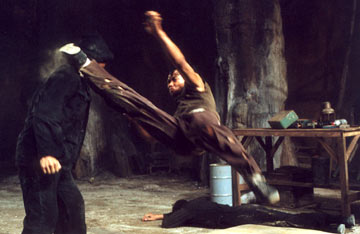|
|
Ong-Bak: The Thai Warrior
(in Thai, with English subtitles)
Directed by Prachya Pinkaew
 Martial-arts extravaganza: Ong-Bak: The Thai Warrior tells a simple story without any detectable use of special effects. It’s an old-school action movie – straight-forward, understandable characters and realistically rendered fight and chase sequences that recall the best of early Bruce Lee and Jackie Chan. Our hero, Ting (Tony Jaa, aka Panom Yeerum) is a humble, religious young man from a small village who has studied “Muay Thai” (Thailand’s traditional form of kick boxing) under an elderly Muay-Thai-master-turned-Buddhist-monk who, in turn, had studied under a legendary master – see what’s coming? The setup involves the theft of the head from the village’s Buddha statue by a greedy, city man with gang connections. The village is evidently doomed without this religious icon, so Ting is sent on a mission to Bangkok to retrieve the head. Incidentally, the title, Ong-Bak, refers to the name of the Buddha statue – the villagers refer to it as if it’s a person. Martial-arts extravaganza: Ong-Bak: The Thai Warrior tells a simple story without any detectable use of special effects. It’s an old-school action movie – straight-forward, understandable characters and realistically rendered fight and chase sequences that recall the best of early Bruce Lee and Jackie Chan. Our hero, Ting (Tony Jaa, aka Panom Yeerum) is a humble, religious young man from a small village who has studied “Muay Thai” (Thailand’s traditional form of kick boxing) under an elderly Muay-Thai-master-turned-Buddhist-monk who, in turn, had studied under a legendary master – see what’s coming? The setup involves the theft of the head from the village’s Buddha statue by a greedy, city man with gang connections. The village is evidently doomed without this religious icon, so Ting is sent on a mission to Bangkok to retrieve the head. Incidentally, the title, Ong-Bak, refers to the name of the Buddha statue – the villagers refer to it as if it’s a person.
Consistent with the tradition of American action films, the hero is impossibly nobel, moral and totally likeable while the bad guys – the gangsters in Bangkok – are pure evil. Simple black and white characters – no subtlety, no nuance. Ting is an extremely reluctant fighter, but the genre dictates that he get lots of action – and when he fights he gets it done with amazing agility and explosive speed. The head gangster is a creepy old guy who speaks through a speech synthesizer, smokes cigarettes through a hole in his neck and mocks Ting’s religious beliefs by claiming to be a god. The only character who falls in between the extremes is the cousin of Ting who lives in Bangkok, Hum Lae (Petchtai Wongkamlao) who initially takes advantage of Ting but comes around to become “the buddy” – another movie cliché but it added just a little human dimension to the otherwise non-stop action. Ting and Hum Lae are mismatched buddies -- the two characters illustrate the contrast between wholesome, small-village values and the corrupt big city.
 True to the dictates of the genre we have the “girl” character -- Hum Lae’s girlfriend Muay (an impressive Pumwaree Yodkamol). Unfortunately her character is underwritten -- they didn’t’ give her much to do other than be underappreciated by Hum Lae while he’s in his lowlife phase and saved by Ting. Interestingly, the filmmakers didn’t go the love triangle route – even when Ting saves her life multiple times. True to the dictates of the genre we have the “girl” character -- Hum Lae’s girlfriend Muay (an impressive Pumwaree Yodkamol). Unfortunately her character is underwritten -- they didn’t’ give her much to do other than be underappreciated by Hum Lae while he’s in his lowlife phase and saved by Ting. Interestingly, the filmmakers didn’t go the love triangle route – even when Ting saves her life multiple times.
In addition to almost non-stop fight scenes, there are a couple of eye-popping chase sequences – one foot chase has Ting gracefully evading the gangsters while maneuvering through a typical Asian obstacle course – lots of people, fruit stands, cars, fences, stores --- but he does it without wreaking total havoc – in contrast to, say, chase scenes in Jackie Chan movies. The other chase sequence is my favorite scene in the movie – can you visualize the three-wheeled, open-air taxis common in Asia? Ting and Hum Lae try to outrace the bad guys in one of those – the scene is unusual, funny, and dramatic in a highly creative and visual way.
 Ong-Bak isn’t a deep, nuanced art movie with some action scenes like House of Flying Daggers or Hero -- it’s a straight-up martial arts movie that sacrifices character development and simplifies story elements for the sake of cramming in the action. But, that said, it is very good for what it is – they shot the scenes in long takes that allows the viewer to see the sweep of what is happening. I wish that current American filmmakers would go back to this style – I’m tired of simulated action via choppy editing. Ong-Bak has a couple of other things over typical martial arts fare: the exotic locale and the traditional Thai Buddhist angle – those elements add appeal -- and all of it came across as genuine and convincing. The crowd in the theater was highly responsive throughout the film and gave a long, loud cheer when the end credits rolled – I haven’t seen that in quite a while. Ong-Bak isn’t a deep, nuanced art movie with some action scenes like House of Flying Daggers or Hero -- it’s a straight-up martial arts movie that sacrifices character development and simplifies story elements for the sake of cramming in the action. But, that said, it is very good for what it is – they shot the scenes in long takes that allows the viewer to see the sweep of what is happening. I wish that current American filmmakers would go back to this style – I’m tired of simulated action via choppy editing. Ong-Bak has a couple of other things over typical martial arts fare: the exotic locale and the traditional Thai Buddhist angle – those elements add appeal -- and all of it came across as genuine and convincing. The crowd in the theater was highly responsive throughout the film and gave a long, loud cheer when the end credits rolled – I haven’t seen that in quite a while.
While Ong-Bak is a highly visual film, the production values (production design, cinematography, etc.) are such that it won’t lose too much in transition to DVD – in fact, it’s been available on DVD for some time – but I enjoyed seeing it in the theater.
Photographs are copyright Magnolia Pictures.
For more information about this film including detailed cast and crew credits, check out The Internet Movie Database by clicking here.
e-mail me
|

